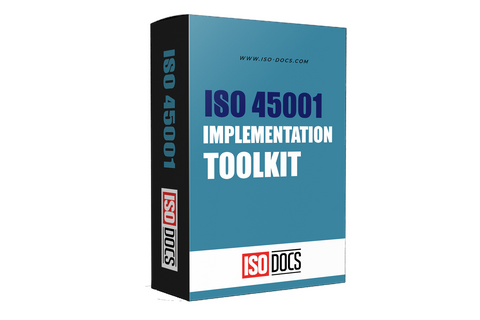ISO 45001 Internal Audit Plan And Schedule Template
Introduction
Ensuring compliance with ISO 45001 standards is crucial for any organization to maintain a safe and healthy work environment for its employees. An internal audit plan and schedule explicitly tailored for ISO 45001 can help organizations assess their occupational health and safety management systems effectively. This template provides a structured approach to conducting internal audits, identifying areas for improvement, and ensuring ongoing compliance with ISO 45001 requirements. Keep reading to learn how this template can streamline your internal audit process and strengthen your organization's commitment to workplace safety.

Importance Of Internal Audit Plan And Schedule In ISO 45001
An internal audit plan and schedule is a critical component of ISO 45001, the international occupational health and safety management system standard. This plan and schedule help ensure that the organization's OH&S management system is effectively implemented, maintained, and continually improved. Having a well-developed internal audit plan and schedule assists in determining an internal audit plan and schedule, which are essential components of ISO 45001, the international standard for occupational health and safety management systems.
An internal audit is a systematic and independent examination of a company's OH&S management system to determine its effectiveness and compliance with the standard's requirements. The internal audit plan outlines the objectives, scope, methodology, and frequency of audits conducted within the organization. It serves as a roadmap for scheduling and conducting internal audits in a structured and planned manner.
The internal audit schedule specifies when audits will be conducted, who will conduct them, and which areas of the organization will be audited. Having a well-defined internal audit plan and schedule is crucial for several reasons. Firstly, it helps ensure that all elements of the OH&S management system are regularly reviewed and assessed for compliance with the standard. This can help identify gaps, weaknesses, or areas for improvement within the system.
Implementing The Audit Plan And Schedule In Your Organization
1. Start by reviewing the audit plan developed for your organization. This plan should outline the objectives of the audit, the scope of work to be performed, and the timeline for completing the audit.
2. Communicate the audit plan and schedule to all relevant stakeholders within the organization. This may include management, employees, and others involved in the audit process.
3. Assign roles and responsibilities to individuals responsible for specific audit tasks. Ensure that everyone understands their role and the expectations for their participation in the audit.
4. Develop a detailed schedule of activities for the audit, including key milestones, deadlines, and deliverables. This schedule should be realistic, and any potential obstacles or challenges during the audit process should be considered.
5. Monitor progress against the audit schedule regularly and promptly address any deviations or delays. This will help ensure the audit stays on track and is completed within the specified timeframe.
6. Conduct regular meetings with the audit team to discuss progress, address any issues that may arise, and provide updates on the audit status.
7. Keep stakeholders informed of the audit's progress, including any findings or recommendations identified during the audit process.
8. Upon the completion of the audit, ensure that a final report is prepared and presented to management. This report should include a summary of the audit findings, recommendations for improvement, and any other relevant information gathered during the audit.

Monitoring And Evaluating The Effectiveness Of The Internal Audit Plan
Monitoring and evaluating the effectiveness of the internal audit plan is crucial to ensure that the objectives and goals of the internal audit function are being met. This process involves regularly assessing the performance of the internal audit team, as well as the overall effectiveness of the internal audit plan.
There are several critical steps involved in monitoring and evaluating the effectiveness of the internal audit plan:
1. Performance Assessments: Regularly evaluate the performance of the internal audit team members to ensure they are carrying out their duties effectively and efficiently. This can include assessing their adherence to policies and procedures, ability to identify and address risks, and overall productivity.
2. Internal Audit Plan Review: Conduct regular reviews of the internal audit plan to assess whether it aligns with the organization's objectives and goals. This can involve evaluating the plan's scope, methodologies, and resources allocated to each audit.
3. Stakeholder Feedback: Gather feedback from key stakeholders, such as senior management and the audit committee, to assess their satisfaction with the internal audit function. This feedback can help identify areas for improvement and ensure that the internal audit plan meets the organization's needs.
4. Key Performance Indicators (KPIs): Establish KPIs to measure the effectiveness of the internal audit plan, such as the number of audits completed, the timeliness of audit reports, and the percentage of audit recommendations implemented by management. Regularly track these KPIs to monitor progress and identify any areas needing improvement.
5. External Assessments: Consider conducting external assessments of the internal audit function, such as quality assurance reviews or benchmarking studies, to objectively evaluate the internal audit plan's effectiveness. This can help identify best practices and areas for improvement.
By regularly monitoring and evaluating the effectiveness of the internal audit plan, organizations can ensure that their internal audit function adds value and contributes to achieving their goals and objectives. Taking a proactive approach to monitoring and evaluating the internal audit plan is essential to identify improvement areas and make necessary adjustments to enhance its effectiveness.
Conclusion
In summary, having a comprehensive internal audit plan and schedule is essential for ensuring compliance with ISO 45001 standards. This template provides a structured approach to conducting audits, identifying areas for improvement, and maintaining a high level of occupational health and safety within the organization. Utilize this template to streamline your auditing process and establish a culture of continuous improvement in workplace safety. Download the Internal Audit Plan and Schedule for ISO 45001 Template today to enhance your organization's commitment to health and safety.


